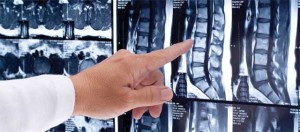By Philip W. Tally, M.D. –


The basic frame that allows us to sit and stand is known as our spinal column. The spinal column is composed of 25 bones from the bottom of the skull to the sacrum or tailbone. When working properly, we never give it a second thought. However, any trauma or disease that creates a fracture within these bones can produce an extraordinary amount of pain. As might be expected, the spinal bones are very large at the bottom and get progressively smaller toward the top near the skull. The larger bones must carry the heavier load making the pain felt from a fracture in that area proportionately greater. Not all fractures are sustained through trauma such as car accidents or falling from heights. A fall from the standing position or a small stepladder can be enough to cause a fracture. As we age, the ability for the bones to withstand this type of injury diminishes, particularly if there are underlying degenerative disorders such as osteoporosis, chronic cortisone treatments, and chronic kidney disease. Women are more susceptible than men because of hormonal changes, but medications for arthritis can contribute to bone density loss. Lifestyle habits including lack of regular exercise, excessive carbonated beverages, and lack of necessary calcium in our diets also increase the chance that a person will suffer an event.
When a fracture has occurred:
The general pain distribution occurs in the middle and frequently down the back toward the tailbone even though the actual fracture is located much higher because of the way that pain radiates. Many patients are surprised to find that tailbone pain is secondary to a fracture that is well above the waistline. If an x-ray is performed, the fracture site may or may not be easily identified. Even if the fracture is a minor one, the pain may still be quite severe.
Typically, if a fracture is minor and does not show progression, conservative management is always the best course. Unfortunately, a minor fracture can show a progression of severity within a few days or weeks depending on the individual’s overall condition. It is always wise to consider repeating an x-ray within a week or two of the initial diagnosis to be certain progression of the fracture is not occurring. Treatments and successful resolution of the pain vary depending on the severity.
When intervention should be considered:
If the patient does not show a gradual improvement in their pain tolerance over a few weeks with conservative management, or if repeated x-rays demonstrate that the bone is showing a loss of height, then intervention should be considered. Options may include a fairly routine outpatient procedure known as Vertebroplasty or Kyphoplasty. If the severity of the fracture is substantial from the initial injury, or if the bone collapses during the conservative management, then some type of spinal surgery will be required for restoring stability and function to the patient.
The advantage to this type of surgery is that we can now remove the destroyed bone and build a new one through a small incision, allowing the person to stand erect again. In doing so, the need for putting in an extensive set of rods and screws can be avoided.
No one wants to consider surgery, but restoring a person to a normal walking condition, with minimal if any discomfort, is such a significant reward for an otherwise permanently debilitating condition.
Certainly, we all want to avoid accidents resulting in this type of trauma, but this is an unexpected part of life. Understanding other conditions such as osteoporosis, osteopenia, proper diet, exercise and taking care of our spine is something we all can do every day to minimize the risk of suffering a permanent disability. If you or someone you know suffers from back pain, please call Neurospinal Associates to set up an appointment for an evaluation.
Neurospinal Associates offers two convenient locations to serve their patients. In Bradenton, they are located in the Riverwalk Professional Park at 200 3rd Avenue West, Suite 200, directly west of the Manatee Memorial Hospital and just North of the Bradenton Herald. Their Sun City location is at 3909 Galen Court, Suite 104. For more information, or to schedule an appointment, please call 941-794-3118 or visit their website: www.nsadoctors.com.
 Southwest Florida's Health and Wellness Magazine Health and Wellness Articles
Southwest Florida's Health and Wellness Magazine Health and Wellness Articles

